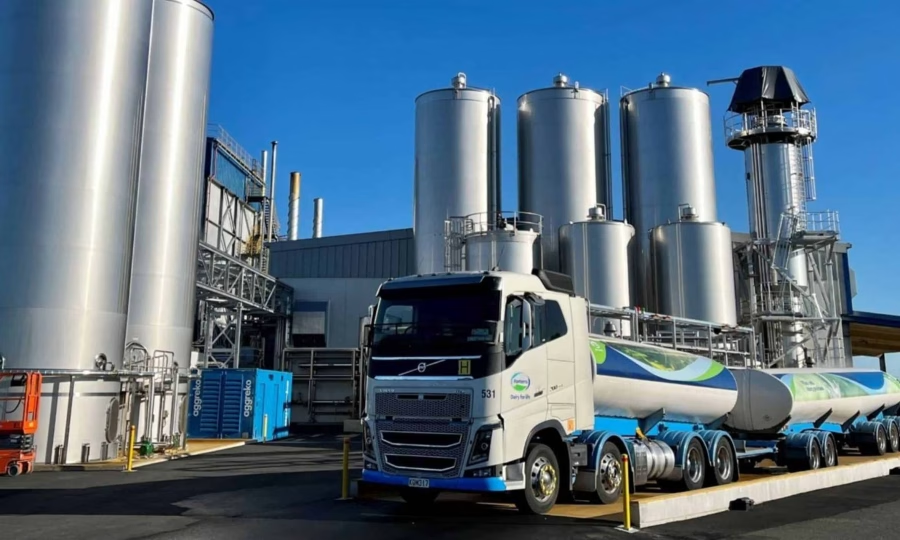Discover how rising dairy prices could benefit farmers. Will strong demand and reduced supply keep prices high through 2025? Learn more.
Summary:
Are you ready for a deep dive into the current state of the dairy market? Today, we’ll explore the forces driving dairy prices upwards and what they mean for your farm. With no expected increase in milk production through at least 2025, the USDA forecasts a promising future for dairy farmers. The USDA has raised the all-milk price for this year by 75 cents to $23.05 per hundredweight and expects further strength into 2025 with a forecast of $23.45 per hundredweight. Dairy prices are rising, with stable prices and robust demand beyond 2025. This tightening supply means higher butter, cheese, nonfat dry milk, and whey prices, including Class III and Class IV. Reduced cow numbers and slower output growth per cow are likely contributors. Additionally, global market patterns, trade policy, and geopolitical events significantly impact dairy pricing, while tariffs and new trade agreements play crucial roles. To capitalize on these market shifts, farmers should monitor milk production trends and adjust their strategies accordingly, incorporating technological advancements and staying compliant with evolving regulations.
Key Takeaways:
- The USDA predicts no increase in milk production until at least 2025 due to lower cow numbers and slower production growth per cow.
- Butter, cheese, nonfat dry milk, and whey prices are expected to remain strong into 2024 and 2025.
- The Class III and Class IV milk prices have been raised in response to recent price strength and reduced milk supply.
- The all-milk price forecast for 2024 improved by 75 cents, reaching $23.05 per hundredweight, with a further 60-cent increase anticipated for 2025.
- Strong demand is projected to persist, positively impacting milk product prices and benefiting farmers financially.

Dairy prices are rising, and if you work in the business, you’ve seen an increase in your bottom line. Recent USDA data supports this trend, with an eye-opening analysis indicating stable pricing and robust demand long beyond 2025. This isn’t a blip; it’s a substantial change that might influence the future of dairy production. The USDA reports, “Expectations for butter, cheese, nonfat dry milk, and whey prices were raised for 2024 due to recent price strength and a reduced milk supply”. The paper identifies various variables contributing to the hopeful forecast, including reduced cow numbers, slower output growth per cow, and robust demand for dairy products. So, how can a dairy farmer benefit from these trends? What tactics can help your farm succeed in this changing market landscape?
| Dairy Product | 2024 Price Forecast | 2025 Price Forecast |
|---|---|---|
| Cheddar Cheese | $1.620 per lb | $1.680 per lb |
| Dry Whey | $0.425 per lb | $0.440 per lb |
| Butter | $2.925 per lb | $3.000 per lb |
| Nonfat Dry Milk (NDM) | $1.180 per lb | $1.200 per lb |
| All Milk Price | $23.05 per cwt | $23.45 per cwt |
Decoding the Dairy Market Surge: Understanding the Forces Behind Rising Prices
When we look at the present status of the dairy market, it’s clear that we’re in the middle of a period of rising prices. According to the most recent USDA data, a substantial and credible source, the cost of all milk has increased significantly, hitting $23.05 per hundredweight. This is a significant milestone for dairy producers who have lately faced changing market circumstances.
Several causes contribute to this upsurge. First, there is a decrease in cow numbers, which naturally decreases total milk output. But there are other issues: production per cow isn’t rising as quickly as previously. These variables combine to generate a tighter supply situation, an essential feature in the present market dynamics.
Why are cow numbers decreasing? Several factors, including aging herds and economic constraints, prompted some farmers to cut herd size. Then, you see slower increases in productivity per cow. Advances in technology and dairy practices need to translate into significant output gains, thus limiting supplies.
This cycle of limiting supply against stable or growing demand creates the conditions for increased pricing. Farmers now benefit from the strength of the price, which may help offset other operational concerns. Understanding these essential characteristics offers a better view of the dairy market’s current state and what may lie ahead.
Global Market Trends: Navigating International Demand and Supply Dynamics
When we look outside our boundaries, global dairy market patterns provide a plethora of information on the causes of price swings. Understanding the worldwide demand and supply dynamics is critical. For example, developing regions in Asia and Africa are witnessing a rapid rise in dairy consumption. This encourages more exports from major dairy producers such as the United States, New Zealand, and the European Union, resulting in higher prices overall.
However, trade policy and geopolitical events considerably impact dairy pricing. Consider the current trade tensions between the US and China. Tariffs may establish obstacles to market entry, resulting in domestic excess supply and reduced pricing. Alternatively, new trade agreements might provide opportunities and boost demand. Monitor changing trade environments for possible effects on dairy pricing.
In addition, geopolitical volatility complicates matters. Conflict zones may disrupt supply networks, generating shortages and pushing prices higher. Consider the current tensions in Ukraine and their impact on global food prices. Such instances highlight the complex network of forces affecting dairy pricing. To navigate these challenges, it’s crucial to diversify your supply sources and maintain a robust risk management strategy.
Staying informed about global market patterns, trade regulations, and geopolitical events can offer a broader perspective on the increase in dairy prices. Not only do local variables influence our terrain, but so does a complex, linked global economy. How prepared are you for navigating these rough waters? By staying informed, you can feel empowered and knowledgeable, ready to make the best decisions for your business.
Preparing for the Future: Navigating Challenges and Seizing Opportunities in the Dairy Market
The dairy market landscape suggests a mix of challenges and opportunities. Farmers should closely monitor several key indicators to make informed decisions about their operations and investments.
- Milk Production Trends: The USDA has signaled that milk production will not surge significantly through at least 2025 due to lower cow numbers and slower productivity growth per cow. Monitoring these trends will help farmers anticipate supply constraints and adjust their production strategies accordingly.
- Price Projections: As recently evidenced, expectations for butter, cheese, nonfat dry milk, and whey prices have been raised, reflecting current price strength and reduced supply. Farmers should consistently review price forecasts for these products to align their pricing strategies and maximize profitability.
- Feed Costs: Another crucial factor is feed cost, which directly impacts production costs. Fluctuations in feed prices can erode margins, so monitoring feed market trends and exploring cost-efficient feed solutions will be essential.
- Global Demand: The international market plays a vital role in the dairy industry’s dynamics. Keeping abreast of global demand trends, trade policies, and currency exchange rates will help farmers better position their products worldwide.
- Regulatory Changes: Stay informed about upcoming regulations affecting dairy farming practices, including environmental policies, labor laws, and animal welfare standards. Proactively adapting to these changes can ensure compliance and sustainability in operations.
- Technological Advancements: Innovations in dairy farming technology, from automated milking systems to advanced data analytics, can drive efficiencies and reduce costs. Investing in and adopting these technologies could provide a competitive edge.
By staying vigilant and informed about these critical indicators, dairy farmers can navigate the market’s complexities, seize growth opportunities, and sustain their operations through the industry’s ups and downs.
Rising Dairy Prices: Beyond the Chart, Real Benefits for Farmers
The sustained high dairy prices are more than simply a statistic on a graph; they provide significant advantages to dairy producers. Have you considered how this pricing strength may affect your bottom line? Higher butter, cheese and nonfat dry milk prices enhance income from farm to market. For instance, a 10% increase in dairy prices could lead to a 15% increase in your farm’s revenue. The USDA’s anticipated increase in all milk prices to $23.45 per hundredweight by 2025 is a statistic we cannot ignore [USDA Report].
Higher pricing may boost profits, enabling you to invest more in your business. Are you contemplating improving your equipment or growing your herd? With increased money, these possibilities become more viable. However, it is also necessary to think strategically. How would these prospective income increases impact your long-term sustainability? Will you invest in technology to improve efficiency or save for future uncertainties?
A balanced approach is required while making decisions under favorable market circumstances. Consider how increased income may assist you in managing obligations, such as loans for equipment or land. By optimizing your cash flow, you may better fulfill your existing responsibilities and prepare for future development. What modifications to your operations make the most sense right now? Perhaps expanding your product line or improving your marketing efforts? Remember, a balanced approach gives you control and reassurance in these changing times.
Addressing Hurdles Amid Optimism: Rising Costs, Labor Shortages, and Market Volatility
Despite the optimistic forecast for dairy prices, several issues might dampen this confidence. Rising feed prices remain a significant worry. With global commodity prices shifting, the cost of feed materials like maize and soybeans may increase abruptly. Have you thought about how to control these expenses? Exploring other feed sources or locking in prices via futures contracts might assist.
Labor shortages are another serious concern. Many dairy farms struggle to attract and keep qualified workers. Are you experiencing this on your farm? Investing in automation and technology may help you alleviate specific labor difficulties, but bear in mind the upfront expenses and learning curve involved with these solutions.
Finally, market turbulence looms over the agriculture industry. Consumer tastes, trade policy, and changes in the global economic situation may significantly influence pricing. How prepared are you for unexpected market shifts? Diversifying your product offerings and building strong client connections might give some protection against these unpredictability shifts.
As we traverse these possible roadblocks, proactivity and flexibility are essential. Staying knowledgeable and open to new tactics can help protect your farm’s future in an ever-changing world.
The Bottom Line
As we negotiate the changing environment of the dairy sector, it is evident that the current market rise presents both possibilities and challenges. Strong demand and limited supply have raised butter, cheese, nonfat dry milk, and whey prices, giving dairy producers a nice financial boost. The USDA’s updated predictions emphasize this possibility, predicting a continuous increase in Class III and Class IV prices through 2025.
However, while we celebrate these achievements, we must stay alert. Rising operating expenses, workforce constraints, and market volatility present substantial difficulties requiring strategic planning. The advantages of these price rises may be temporary if we are not prepared to confront these challenges head-on.
So, how do you plan to prepare your farm for the future? Consider broadening your product offers, investing in efficient technology, and hiring dependable employees. Today’s choices may be the key to success in tomorrow’s market. Let us use these findings to take action and secure our farms’ long-term success.
Learn more:
- US Dairy Farmers’ Revenue and Expenditure rose slightly in March
- Is the Summer Heat Finally Over? Dairy Farmers See Milk Production Stabilize, but Challenges Remain!
- Navigating the Waves: Dairy Producers Defy Challenges to Keep Barns Full Amid Soaring Milk Prices and Adverse Conditions
 Join the Revolution!
Join the Revolution!
Bullvine Daily is your essential e-zine for staying ahead in the dairy industry. With over 30,000 subscribers, we bring you the week’s top news, helping you manage tasks efficiently. Stay informed about milk production, tech adoption, and more, so you can concentrate on your dairy operations.







 Join the Revolution!
Join the Revolution!







